#MRF challenge
Explore tagged Tumblr posts
Text
i write about maximum ride because james can't
#his ghostwriters at least gave it a shot#looking at my ao3 fandom distribution does take a year off my life but here we are#every fic i write is a direct challenge about how weird and complex i can make the plot without ever descending to whatever the fuck mrf wa#maximum ride#mrposting
2 notes
·
View notes
Text
It looks like the poll has about to the end.
I'll spin it when I finish my OC Challenges Wheel, and it looks like Peanuts OC Challenge goes first.

1 note
·
View note
Text
Akash Deep Reveals How Virat Kohli-gifted Bat Saved the Gabba Test for India

BGT 2025: Indian pacer Akash Deep revealed how Virat Kohli played an important role in helping the team avoid a follow-on during the Gabba Test in the 2024-25 Border-Gavaskar Trophy (BGT). Akash Deep shared a memorable moment when Virat Kohli offered him one of his signature bats during the third Test.
The Men in Blue initially took a 1-0 lead in the Border-Gavaskar Trophy with an emphatic victory in Perth, but Australia regained control over the following six weeks. The hosts won three out of the remaining four matches and reclaimed the BGT trophy after a decade of India’s dominance in the series.
Read Also: Virat Kohli Career Stats And Overview

Virat Bhaiya Ne Khud Mujhse Pucha, 'Tumko Bat Chahiye?' - Akash Deep
During a challenging match at the Gabba in Brisbane, Akash Deep, and Jasprit Bumrah shared a crucial partnership of 47 runs for the tenth wicket, helping India avoid a follow-on and all but securing a draw in rain-affected conditions.
Reflecting on his innings, Akash Deep revealed he used one of Virat Kohli’s signature bats, which the former Indian skipper had offered him before the match. Akash recalled how Kohli had asked him if he needed a bat, to which he eagerly accepted.
"Yes, that was Virat bhaiya's bat, the one with MRF logo, everyone knows," Akash said in a sit-down with PTI.
"Bhaiyya (Kohli) ne khud mujhse pucha 'Tumko bat chahiye?' (Virat bhaiyya asked me, do you need a bat?). Maine bola 'Haan bhaiyya, aapka bat kaun nahi lena chahega duniya mein?' (I said ‘Yes, who in the world wouldn’t want your bat?’) Then he presented it to me," he explained further.
Read Also: Shubman Gill Leads IND To 1st Edgbaston Test Win

Virat Kohli On His Own Gave Me The Bat - Akash Deep
Akash Deep admitted that it felt intimidating to ask Virat Kohli, given his stature and focus during match time. However, Kohli, on his own initiative, offered Akash his bat. Akash made excellent use of the bat, playing a crucial role in helping India avoid a loss in the game.
"I have been there with bhaiyya (Kohli) for some time now. But you always have that thing at the back of your mind, whether it is the right thing to ask for a bat from someone of Virat bhaiyya's stature.”
"Especially during match time, when he is focussed and in his zone, you don't want to disturb him but bhaiyya, on his own, gave me the bat," said Akash.
Read Also: Shubham Gill And India Dominate On Day 4 Vs ENG
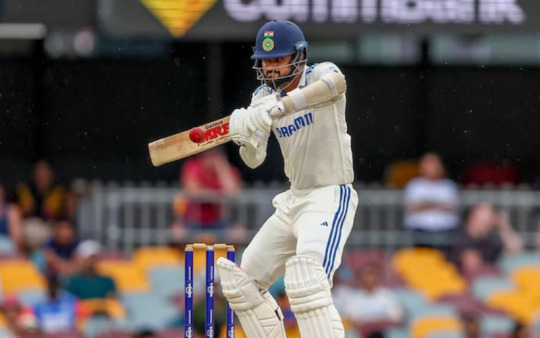
This Was Not the First Time Kohli Had Gifted Akash a Bat
Akash joined Bumrah when India still needed 33 runs to avoid the follow-on. They managed to help the team avoid the follow-on with a patient defense. Akash cleared the follow-on mark with a cut shot over the slip cordon before launching a memorable six over midwicket off the very next ball.
This wasn't the first time Virat had gifted Akash a bat. During the home series against Bangladesh, Kohli had also given Akash one of his signature bats, showcasing the strong camaraderie within the Indian team.
Read Also: Pakistan vs Sri Lanka Dream11 Prediction CWC
0 notes
Text
A Cleaner Future: Transforming Waste Management in Kerala
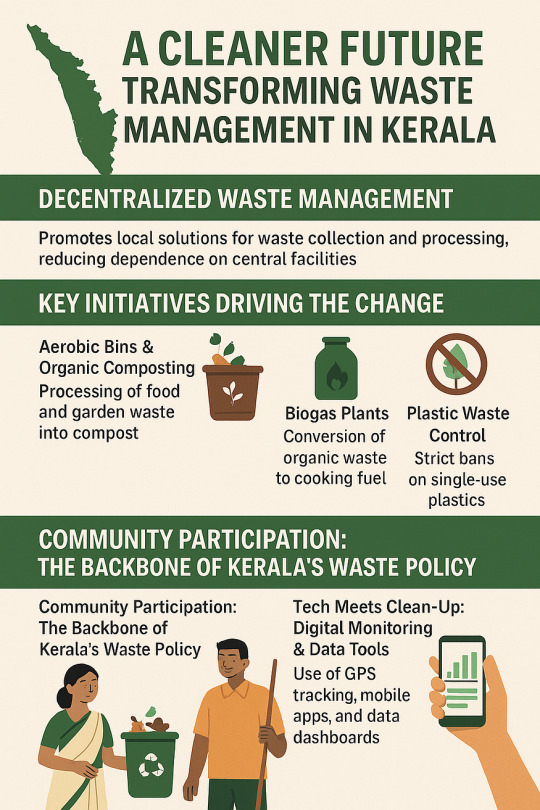
In recent years, waste management in Kerala has undergone a remarkable transformation. Once burdened with growing landfills and poor waste disposal practices, the state is now a frontrunner in sustainable waste solutions, thanks to a mix of innovative technologies, community participation, and strong policy support.
The Shift Toward Decentralized Waste Management
Kerala has embraced a decentralized waste management model — one that encourages each household, ward, and municipality to manage waste locally. Rather than relying on massive central landfills, small-scale treatment plants and composting units are being established across the state.
Key Initiatives Driving the Change
Aerobic Bins & Organic Composting Urban areas now use aerobic compost bins to process food and garden waste, turning it into valuable compost that supports local agriculture.
Biogas Plants Households, schools, and markets are installing biogas units that convert organic waste into cooking fuel, reducing dependence on LPG and firewood.
Material Recovery Facilities (MRFs) Segregated dry waste is sent to MRFs where it is sorted, recycled, and processed, creating income for local workers and reducing landfill load.
Plastic Waste Control Strict plastic bans and extended producer responsibility (EPR) policies have reduced single-use plastic drastically, encouraging businesses to adopt sustainable packaging.
Community Participation: The Backbone of Kerala’s Waste Policy
What makes waste management in Kerala truly effective is the active role played by citizens. Local residents are encouraged to:
Practice source segregation (separating wet and dry waste at home)
Participate in clean-up drives organized by local bodies
Use kitchen compost bins for daily biodegradable waste
Attend workshops on zero-waste living and eco-friendly alternatives
Tech Meets Clean-Up: Digital Monitoring & Data Tools
Many municipalities have adopted GPS-enabled garbage collection, mobile tracking apps, and real-time data dashboards to monitor progress and ensure transparency in waste collection and processing.
Kerala’s Model Cities & Awards
Cities like Alappuzha, Thiruvananthapuram, and Kochi have been recognized nationally and internationally for their waste management systems. Alappuzha, in particular, was featured by the United Nations Environment Programme (UNEP) as one of the top five clean cities in the world using decentralized solid waste management.
Challenges Ahead
Despite the progress, Kerala still faces challenges like:
Inconsistent segregation practices in rural belts
Limited awareness in tourist-heavy areas
Need for better hazardous waste disposal systems
With continued education and infrastructure upgrades, these gaps can be bridged.
Conclusion
The evolution of waste management in Kerala showcases how a focused, community-driven, and tech-backed approach can lead to cleaner, more livable cities. As Kerala continues to innovate and inspire, it sets a powerful example for the rest of India and beyond — a vision of a zero-waste future grounded in local action and global responsibility.
#biogas in kerala#biogas plant for home#kerala#biogas#incinerator manufacturers in kerala#portable biogas plant for home#incinerators in kerala
0 notes
Text
Kenya Two-Wheeler Tire Market Growth and Development Insight - Size, Share, Growth, and Industry Analysis
MarkNtel Advisors recently published a detailed industry analysis of the Kenya Two-Wheeler Tire Market. The report covers growth trends, geographical marketing strategies, challenges, opportunities, and drivers influencing the market.
✅In case you missed it, we are currently revising our reports. Click on the below to get the latest research data with forecast for years 2025 to 2030, including market size, industry trends, and competitive analysis. It wouldn’t take long for the team to deliver the most recent version of the report.
Insights and Analysis of the Kenya Two-Wheeler Tire Market (2024-2030)
The Kenya Two-Wheeler Tire Market is estimated to grow at a CAGR of around 13.06% during the forecast period, i.e., 2024-30.
Access the detailed PDF Sample report – https://www.marknteladvisors.com/query/request-sample/kenya-two-wheeler-tire-market.html
What is driving the Kenya Two-Wheeler Tire Market?
Growing Two-Wheeler Sales Due to High Unemployment to Drive the Market – High levels of unemployment in Kenya push individuals towards entrepreneurial endeavors and participation in the informal economy. Many unemployed individuals turn to activities such as motorcycle taxis, courier services, and small-scale businesses for income generation. As a result, there is a growing demand for two-wheelers to support these informal economic activities. According to the World Bank, the boda boda (motorcycle taxi) sector in Kenya employs over 1.5 million young people and contributes about USD 1.4 billion to the economy each year. This high usage of motorcycles & scooters directly drives the demand for tires in the market.
Furthermore, the growing introduction of motorcycle taxis, which are commonly called boda-bodas in African countries, has become a prominent mode of transportation, particularly in urban and peri-urban areas.
In 2023, Uber launched an electric boda in Kenya, that offers affordable, comfortable, and reliable means of mobility within the city.
Consequently, unemployed individuals turn to motorcycle taxi services as a means of generating income across the region. Therefore, the proliferation of motorcycle taxis significantly contributes to the overall sales of motorcycles, which positively generates the demand for tires in the upcoming years.
What segments define the Kenya Two-Wheeler Tire Market from 2024 to 2030? How do these segments contribute to market dynamics and growth?
By Vehicle Type
(Scooter & Moped, Motorcycle),
By Demand Type
(OEMs, Replacement),
By Tire Type
(Radial, Bias),
By Price Category
(Budget (Upto USD 11 Per Unit), Economy (USD 12 to 30 Per unit), Premium (Above USD 30 Per Unit)-Market Size & Forecast 2019-2030, Thousand Units,
By Sales Channel
(Online, Multi-brand Stores, Exclusive Outlets, Direct),
By Tire Size
(80/100-17, 100/90-17, 2.75 x 17, 3.00 x 17, 3.00 - 18, 90/90 - 17, Others (110/80-17, 90/90-18, 100/80-17,110/70-17,150/60-17, 120/80 - 17 etc.))
By Regions
East, West, North, South
Explore the Complete Kenya Two-Wheeler Tire Market Analysis Report – https://www.marknteladvisors.com/research-library/kenya-two-wheeler-tire-market.html
Who are the leading key players shaping the Kenya Two-Wheeler Tire Market landscape?
Bridgestone Corporation, Michelin, Continental AG, Yokohama TWS (Mitas), Pirelli Tyre S.p.A, Dunlop Tyres, MRF, Shinko Tyres, CEAT, and Others.
Questions Addressed in this Study
1.What factors are driving the Kenya Two-Wheeler Tire Market growth?
2.How is the Kenya Two-Wheeler Tire Market expected to grow over the next five years?
3.What are the key insights into the current trends in the Kenya Two-Wheeler Tire Market?
4.What is the current size of the Kenya Two-Wheeler Tire Market, and how is it projected to change in the future?
6.What is the future outlook for the Kenya Two-Wheeler Tire Market in terms of technological advancements and market expansion?
For a Customized Analysis Report, Just Drop Your Inquiry Here – https://www.marknteladvisors.com/query/request-customization/kenya-two-wheeler-tire-market.html
Why MarkNtel Advisors?
MarkNtel Advisors is a leading research, consulting, & data analytics firm that provides an extensive range of strategic reports on diverse industry verticals. We deliver data to a substantial & varied client base, including multinational corporations, financial institutions, governments, & individuals, among others.
Our specialization in niche industries & emerging geographies allows our clients to formulate their strategies in a much more informed way and entail parameters like Go-to-Market (GTM), product development, feasibility analysis, project scoping, market segmentation, competitive benchmarking, market sizing & forecasting, & trend analysis, among others, for 15 diverse industrial verticals.
For Media Inquiries, Please Contact:
Email: [email protected]
Sales Office: 564 Prospect St, B9, New Haven, Connecticut, USA-06511
Corporate Office: Office No.109, H-159, Sector 63, Noida, Uttar Pradesh-201301, India
0 notes
Text
Unlocking the Best Experience with a Trusted Car Tyre Dealer in Ghodbunder Thane: A Comprehensive Guide
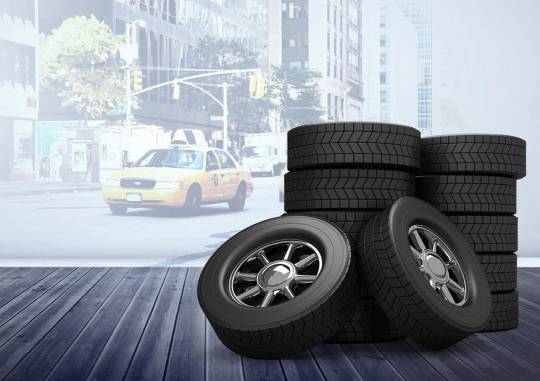
When it comes to vehicle safety, performance, and comfort, choosing the right tyre and wheel dealer can make all the difference. Whether you’re driving a car, riding a bike, or upgrading your vehicle’s aesthetics, your local car tyre dealer in Ghodbunder Thane plays a crucial role. With increasing demand for top-notch vehicle care and performance, residents and commuters in Ghodbunder Thane are constantly seeking reliable tyre and wheel services.
This blog dives deep into what makes a car tyre dealer in Ghodbunder Thane, an alloy wheel shop in Ghodbunder Thane, and a bike tyre dealer in Ghodbunder Thane the go-to destination for vehicle owners. We’ll also explore the importance of choosing an authorised Ceat tyre dealer in Thane or MRF tyre dealer in Thane for long-lasting tyre performance.
Understanding the Role of a Car Tyre Dealer in Ghodbunder Thane
The road conditions in and around Ghodbunder demand tyres that can withstand daily wear while offering smooth, safe rides. A good car tyre dealer in Ghodbunder Thane doesn’t just sell tyres — they help you select the best option based on your driving habits, vehicle type, and terrain preferences. Their knowledge extends to tyre fitting, wheel balancing, alignment, and regular maintenance tips to increase tyre life.
Dealers in Ghodbunder Thane are known for stocking a wide range of brands, sizes, and types of tyres — from high-performance models to economical, all-season options. Their role extends beyond transactions to becoming trusted advisors for your vehicle’s wellbeing.
Why Visit an Alloy Wheel Shop in Ghodbunder Thane?
Alloy wheels aren’t just about style — they contribute to vehicle performance. An alloy wheel shop in Ghodbunder Thane offers a range of modern alloy designs that are not only lighter but also enhance heat dissipation, improve fuel efficiency, and offer a smoother ride compared to traditional steel wheels.
Shops in this region are well-stocked with top-grade alloy wheels suitable for different vehicle models. Moreover, they provide proper guidance on compatibility, size upgradation, and alignment, helping customers make informed decisions. Quality alloy wheel shops in Ghodbunder Thane also offer wheel restoration, painting, and customisation services for vehicle enthusiasts.
Importance of Choosing a Reliable Bike Tyre Dealer in Ghodbunder Thane
Two-wheeler riders face unique challenges — potholes, rough patches, and traffic congestion require tyres that offer great grip, durability, and comfort. A good bike tyre dealer in Ghodbunder Thane understands these local riding needs and recommends tyres accordingly.
Whether you ride a daily commuter or a performance bike, the dealer can help select tyres that suit your terrain, speed, and mileage requirements. These dealers often carry both tubeless and tube-type tyres, ensuring options for every rider. They also provide tyre fitting, puncture repair, and guidance on maintaining correct air pressure to ensure road safety.
Benefits of Buying from a Ceat Tyre Dealer in Thane
CEAT has been a trusted name in the Indian tyre industry for decades. An authorised Ceat tyre dealer in Thane ensures you receive genuine products with warranty coverage and post-sale services. These tyres are built to handle diverse road conditions and offer excellent traction, cornering ability, and long lifespan.
From passenger cars to bikes and SUVs, Ceat dealers offer a wide variety of options. The added value of expert installation, regular rotation services, and access to manufacturer offers makes purchasing from an authorised dealer a smart move.
Buying from a Ceat tyre dealer also ensures:
Genuine product guarantee
Proper fitting and balancing
Access to the latest product launches
Professional recommendations based on vehicle type
What Makes an MRF Tyre Dealer in Thane Stand Out?
MRF is another leading brand with a strong presence across Indian roads. An authorised MRF tyre dealer in Thane is more than a seller — they’re a vehicle partner committed to enhancing your driving or riding experience.
With superior grip, puncture resistance, and load-carrying capacity, MRF tyres are preferred by both individual vehicle owners and commercial operators. Dealers in Thane provide authentic MRF tyres backed by company warranties, trained fitment services, and after-sales support.
These dealers often stock tyres for:
Passenger vehicles
Sports and performance cars
Commercial vehicles
Two-wheelers and scooters

Key Factors to Consider When Choosing a Tyre or Wheel Dealer
When you’re searching for the right car tyre dealer in Ghodbunder Thane, or any other specialised dealer, a few things should be non-negotiable:
Product Variety: Look for dealers that stock a wide range of tyres and wheels from top national and international brands.
Expert Guidance: A good dealer helps you choose based on actual driving needs rather than just price.
Installation Services: Opt for stores offering fitment, alignment, and balancing in-house.
Warranty and Support: Dealers should provide brand-authorised products with valid warranties.
Customer Reviews: Always check local reviews and feedback to gauge service quality and reliability.
The Local Advantage in Ghodbunder Thane
Why shop local? A car tyre dealer in Ghodbunder Thane not only understands the city’s traffic, roads, and weather conditions, but also provides quicker, more responsive service. Whether you need emergency replacement or routine maintenance, a local dealer ensures minimal downtime.
Shops in this area are known for their professionalism, product knowledge, and wide inventory. Having a one-stop solution for cars and bikes alike, including alloy wheel shops in Ghodbunder Thane, adds to customer convenience and satisfaction.
Customisation and Style: The Modern Trend
Today’s vehicle owners seek performance and personality. The increasing popularity of alloy wheels reflects this shift. An alloy wheel shop in Ghodbunder Thane can help you select designs that complement your vehicle’s aesthetics and improve handling.
Tyre upgradation is also trending. More people are moving from standard to premium options for better mileage, safety, and comfort. By working with a knowledgeable car tyre dealer in Ghodbunder Thane, you can tailor your vehicle setup to suit your lifestyle, whether it’s long highway trips, off-roading, or city commuting.
Conclusion: Making the Right Choice in Ghodbunder Thane
Choosing the right car tyre dealer in Ghodbunder Thane, alloy wheel shop in Ghodbunder Thane, or bike tyre dealer in Ghodbunder Thane is more than just a transactional decision — it’s about building a relationship with a vehicle care expert.
Whether you’re opting for a trusted Ceat tyre dealer in Thane or a reliable MRF tyre dealer in Thane, what matters most is the expertise, range, and after-sales service that the dealer provides.
In Ghodbunder Thane, the options are plenty, but with the right information and a bit of research, you can drive away with confidence, knowing your vehicle is equipped with quality tyres and wheels that promise performance, safety, and style.
Your vehicle deserves the best, and it starts with making the right choice today.
#Car Tyre Dealer in Ghodbunder Thane#Alloy Wheel Shop in Ghodbunder Thane#Bike Tyre Dealer in Ghodbunder Thane#ceat tyre dealer in thane#mrf tyre dealer in thane
0 notes
Text
Best Tyres for Indian Roads: A Guide for Every Vehicle
India’s diverse road conditions—from smooth highways to rough rural terrains—demand tyres that can deliver durability, safety, and comfort. Choosing the best tyres for Indian roads is crucial for every vehicle owner who wants to ensure optimal performance and long-lasting reliability.
Why Tyre Choice Matters in India
Indian roads can be unpredictable. Urban areas might have potholes and uneven surfaces, while rural roads often lack proper maintenance. Tyres designed specifically for these conditions offer better grip, enhanced durability, and improved fuel efficiency.
When selecting tyres, consider factors like tread pattern, rubber quality, and load rating. Tyres with deeper treads provide excellent grip on wet and muddy roads, reducing the risk of skidding. Additionally, tyres made from high-quality compounds can withstand the harsh heat and rough usage typical in India.
Popular Tyre Brands for Indian Roads
Some brands have earned a reputation for making tyres suited to Indian conditions. MRF, Apollo, CEAT, and JK Tyres are among the most trusted names. These companies offer a range of options that cater to everything from two-wheelers to SUVs.
For passenger cars and SUVs, look for tyres that balance ride comfort with durability. Many Indian drivers prefer tyres with reinforced sidewalls to better handle potholes and curbs without damage.
Nexon EV Tyre Size and What You Should Know
Electric vehicles are rapidly gaining popularity in India, with models like the Tata Nexon EV leading the charge. Understanding the Nexon EV tyre size is essential for maintaining the vehicle’s efficiency and safety.
The Tata Nexon EV typically comes equipped with tyres sized 215/60 R16. This specification means the tyre width is 215 mm, the aspect ratio (sidewall height) is 60% of the width, and the tyre fits 16-inch wheels.
Choosing the right tyre size is important because it affects the car’s handling, braking, and overall range. Since electric vehicles rely heavily on battery efficiency, selecting tyres that minimize rolling resistance can help maximize the driving range.
Tips for Choosing the Best Tyres for Indian Roads
Match Tyre Size and Specifications: Always follow the manufacturer’s recommended tyre size. For vehicles like the Nexon EV, sticking to the 215/60 R16 size ensures optimal performance.
Look for Weather-Appropriate Tyres: Consider all-weather or mud-and-snow tyres if you frequently drive in rainy or challenging terrain.
Check Tyre Ratings: Load index and speed ratings are important. Ensure the tyres can safely support your vehicle’s weight and driving speeds.
Regular Maintenance: Rotate tyres regularly and keep an eye on tyre pressure to extend tyre life and improve fuel efficiency.
Conclusion
Selecting the best tyres for Indian roads requires careful consideration of the road conditions, vehicle type, and driving style. For EV owners, understanding the Nexon EV tyre size is vital to keep your electric SUV running efficiently. Investing in quality tyres not only enhances safety but also ensures a smoother and more comfortable ride across India’s varied landscapes.
0 notes
Text
Destination for Car Tyre Change in Grant Road: Why Crown Tyre Service Stands Out
Driving through the vibrant streets of Grant Road, Mumbai, is an adventure, but it comes with challenges like heavy traffic, uneven roads, and unexpected debris. Your car’s tyres are your first line of defense against these conditions, ensuring safety, comfort, and performance. When it’s time to replace worn-out tyres or fix a puncture, finding a reliable destination for car tyre change in Grant Road is crucial. Crown Tyre Service, located near Apsara Cinema on Lamington Road, is a trusted tyre shop offering premium brands, expert fitting, and exceptional customer care.

In this guest post, we’ll explore why timely tyre changes are essential, what to look for in a tyre service provider, and why Crown Tyre Service is the top destination for car tyre change in Grant Road. Whether you’re a daily commuter or a weekend road-tripper, this guide will help you keep your car road-ready.
Why Tyre Changes Are a Must for Grant Road Drivers
Grant Road’s bustling roads, from Lamington Road to Bhadkamkar Marg, demand tyres that can handle heavy traffic, monsoon rains, and occasional debris. Regular tyre changes are vital for:
Safety: Worn tyres with low tread depth reduce grip, increasing the risk of skidding, especially during Mumbai’s monsoons.
Performance: New tyres improve handling, braking, and ride comfort, essential for navigating Grant Road’s congested streets.
Fuel Efficiency: Old tyres increase rolling resistance, reducing fuel economy by up to 8%. Fresh tyres optimize performance and save fuel.
Cost Savings: Replacing tyres before they cause alignment or suspension issues prevents expensive repairs.
Aesthetic Appeal: New tyres enhance your car’s look, boosting its resale value.
In a busy area like Grant Road, where road conditions can wear tyres quickly, choosing a reliable destination for car tyre change in Grant Road like Crown Tyre Service ensures your vehicle stays safe and efficient.
Signs You Need a Tyre Change
Knowing when to replace your tyres can prevent breakdowns and ensure safety. Watch for these signs:
Low Tread Depth: Tread depth below 1.6 mm (India’s legal limit) reduces traction. Check using a tread depth gauge or the tyre’s wear indicators.
Visible Damage: Cracks, cuts, or bulges on the sidewall signal structural issues, risking blowouts.
Uneven Wear: Indicates misalignment or improper inflation, requiring a tyre change and wheel alignment.
Vibrations or Handling Issues: Excessive vibrations or poor steering suggest tyre wear or damage.
Tyre Age: Tyres older than 6 years should be replaced, even with low mileage, due to rubber degradation.
Frequent Punctures: Repeated leaks or punctures indicate it’s time for new tyres.
If you notice these signs, visit a trusted destination for car tyre change in Grant Road, such as Crown Tyre Service, for expert inspection and replacement.
What Makes Crown Tyre Service the Best Choice?
Located near Apsara Cinema on Lamington Road, Crown Tyre Service is a premier tyre shop in Grant Road, Mumbai, known for its quality and customer-focused approach. Here’s why it’s the leading destination for car tyre change in Grant Road:
1. Premium Tyre Brands for All Vehicles
Crown Tyre Service offers a wide selection of top-tier tyre brands, including Michelin, Bridgestone, Apollo, MRF, CEAT, and Yokohama. Whether you drive a compact hatchback like a Maruti Alto, a sedan like a Honda Civic, or an SUV like a Toyota Fortuner, they have the right tyre size and type for your vehicle’s needs.
2. Professional Tyre Change Services
Crown Tyre Service provides a range of tyre-related services, including:
Tyre Replacement: Fast, precise fitting of new tyres, ensuring safety and performance.
Wheel Balancing: Free with every tyre purchase (saving ₹150–₹200 per tyre), reducing vibrations and wear.
Wheel Alignment: Corrects misalignment to extend tyre life and improve handling (priced at ₹500–₹1,000).
Puncture Repairs: Quick fixes for minor punctures, with replacements advised for severe damage.
Tyre Rotation: Promotes even wear, recommended every 6,000–8,000 km.
Their advanced equipment and skilled technicians ensure quick, high-quality service, often completed within an hour.
3. Prime Location in Grant Road
Situated in the heart of Grant Road, near landmarks like Minerva Cinema and Bhadkamkar Marg, Crown Tyre Service is easily accessible for residents of Grant Road, Kemps Corner, Gamdevi, and nearby areas like Mumbai Central and Parel. Its central location makes it a convenient destination for car tyre change in Grant Road.
4. Transparent Pricing and Exclusive Offers
Crown Tyre Service offers competitive pricing with no hidden fees. They provide attractive deals, such as free wheel balancing with every tyre purchase and discounts on premium brands. For example, a set of four CEAT tyres for a compact car may cost ₹14,000–₹24,000, including free balancing, saving you up to ₹600.
5. Exceptional Customer Care
Customers rave about Crown Tyre Service’s friendly staff and professional service. One reviewer shared, “I needed a quick tyre change after a puncture, and Crown Tyre Service had me back on the road in no time. Their advice on tyre selection was spot-on!” This customer-centric approach has earned them a strong reputation in Grant Road.
6. Additional Car Maintenance Services
Beyond tyre changes, Crown Tyre Service offers:
Battery Checks: Ensures reliable starting and electrical performance.
Brake Inspections: Verifies brake pad condition for safe stopping.
Tyre Maintenance Guidance: Tips on pressure checks and rotation to maximize tyre life.
Wheel Alignment Services: Prevents uneven wear and improves fuel efficiency.
This comprehensive approach makes Crown Tyre Service a one-stop shop for car care.
Tyre Change Costs at Crown Tyre Service
The cost of a tyre change depends on factors like tyre brand, size, and additional services. Here’s an approximate breakdown at Crown Tyre Service:
Compact Cars (e.g., Tata Tiago, Hyundai i20):
Budget Tyres (CEAT, Apollo): ₹3,500–₹6,000 per tyre
Premium Tyres (Michelin, Bridgestone): ₹6,500–₹10,000 per tyre
Sedans (e.g., Volkswagen Vento, Skoda Slavia):
Budget Tyres: ₹5,000–₹8,000 per tyre
Premium Tyres: ₹8,500–₹12,000 per tyre
SUVs and Luxury Cars (e.g., Hyundai Creta, BMW X3):
Budget Tyres: ₹7,000–₹10,000 per tyre
Premium Tyres: ₹12,000–₹20,000+ per tyre
Additional Services:
Wheel Balancing: Free with tyre purchase (otherwise ₹150–₹200 per tyre)
Wheel Alignment: ₹500–₹1,000
Puncture Repair: ₹200–₹500 per tyre
Contact Crown Tyre Service at their Grant Road location or visit crowntyreservice.in for a precise quote tailored to your vehicle.
Why Grant Road is a Tyre Service Hub
Grant Road, a lively commercial and residential area in South Mumbai, is home to 24 car tyre dealers and 47 tyre shops, making it a key hub for automotive services. Its proximity to major roads like Lamington Road and easy access to areas like Kemps Corner, Gamdevi, and Mumbai Central make it ideal for car maintenance. Mumbai’s monsoon rains, heavy traffic, and occasional road debris underscore the need for reliable tyre services, and Crown Tyre Service meets this demand with its quality and accessibility.
Comparing Crown Tyre Service with Competitors
Grant Road hosts several tyre shops, such as Delhi Tyres and Pal Tyres, but Crown Tyre Service stands out for:
Premium Brand Availability: Stocks Michelin, Bridgestone, and Apollo, unlike smaller shops with limited options.
Expert Technicians: Uses advanced equipment for precise fitment and balancing.
Exclusive Offers: Free wheel balancing and competitive pricing provide better value than competitors like Delhi Tyres (4.1/5 rating).
Customer Focus: High ratings for fast service and personalized advice.
While other shops may offer lower prices, Crown Tyre Service’s quality and reliability make it the top destination for car tyre change in Grant Road.
Tips for Tyre Maintenance in Grant Road
To extend your tyres’ lifespan, follow these tips:
Check Tyre Pressure Monthly: Maintain 30–35 PSI (check your car’s manual) for optimal performance.
Rotate Tyres: Rotate every 6,000–8,000 km to ensure even wear.
Monitor Tread Depth: Replace tyres when tread depth falls below 1.6 mm.
Avoid Harsh Driving: Reduce speeding and hard braking to minimize wear.
Schedule Alignments: Align wheels after tyre changes to prevent uneven wear.
For expert tyre care, visit Crown Tyre Service for professional guidance tailored to Grant Road’s conditions.
Why Choose Crown Tyre Service Over Online Platforms?
Online tyre shops like Tyresnmore and CEAT Shoppe offer convenience, but Crown Tyre Service provides hands-on expertise and immediate service. Their physical location in Grant Road allows for personalized consultations, ensuring you choose the right tyres. Same-day fitting and free wheel balancing give them an edge over online-only providers.
How to Book a Tyre Change at Crown Tyre Service
Booking is simple:
Visit Their Website: Explore tyre options at Crown Tyre Service.
Call for a Quote: Contact their Grant Road team to discuss your needs.
Schedule a Visit: Book a slot for quick fitting, often done in under an hour.
Drive Confidently: Enjoy safe rides with your new tyres.
For urgent needs, Crown Tyre Service offers prompt service to minimize downtime.
Conclusion
For car owners in Grant Road, finding a trusted destination for car tyre change in Grant Road is key to safe and enjoyable driving. Crown Tyre Service, located near Apsara Cinema on Lamington Road, offers premium tyre brands, expert fitting, and free wheel balancing, making it the go-to choice for quality and convenience. With transparent pricing, exceptional customer care, and a central location, they ensure your car is ready for Mumbai’s challenging roads. Don’t let worn tyres compromise your safety. Visit Crown Tyre Service or contact their Grant Road team today to book your tyre change. Choose the leading destination for car tyre change in Grant Road and drive with confidence!
0 notes
Text
The Role of Integrated Waste Management in Urban India’s Waste Challenges
The Role of Integrated Waste Management in Urban India's Waste Challenges
India’s urban transformation is among the most dynamic in the world. Every minute, over 25–30 people migrate to Indian cities, bringing aspirations for better livelihoods—and generating an ever-growing volume of waste in the process. From overflowing landfills and unsegregated garbage to informal recycling systems and illegal dumping, urban India faces a mounting solid waste management crisis. Addressing this challenge isn’t just about collection—it demands a system-wide shift in how we treat, reuse, and recover value from waste. This is where Integrated Waste Management (IWM) comes in—a holistic approach that brings together multiple waste streams, technologies, and treatment practices under one coordinated framework. For cities aiming to become cleaner, greener, and more resilient, integrated solid waste management is not just an option—it’s a necessity.
Urban India’s Waste Crisis: A Snapshot As per Clean India Journal, India’s cities generate over 160,000 tons of municipal solid waste every single day. According to Earth5R national estimates: Less than 30% of this waste is treated
Over 50% ends up in open landfills or dump yards
Most waste is unsegregated, making processing inefficient
As urbanization accelerates, these numbers are expected to rise sharply—straining city infrastructure, polluting air and water sources, and increasing public health risks. Clearly, piecemeal or reactive solutions are no longer enough. Indian cities need a systemic, integrated approach to solid waste management—one that connects all stages of the waste lifecycle in a resource-efficient, environmentally responsible way. What Is Integrated Waste Management (IWM)? Integrated Waste Management (IWM) is a comprehensive, strategic approach to dealing with municipal solid waste that focuses on optimizing each stage of the waste lifecycle—from generation to disposal. Unlike traditional waste handling methods that treat waste streams in isolation, IWM integrates various technologies, policies, and operational practices under a unified framework to maximize resource recovery and minimize environmental impact. At its core, IWM is about creating a circular system where waste is not just collected and dumped, but systematically transformed into resources—through a blend of prevention, recycling, energy recovery, and scientific disposal. The key elements of Integrated Waste Management are:
Segregation at Source Effective solid waste management begins with citizens and businesses separating waste at the point of generation. This includes dividing waste into wet (biodegradable), dry (recyclables), and hazardous categories. Source segregation is essential for efficient downstream processing and ensures higher recovery rates for recyclable and organic materials.
Efficient Collection and Transportation IWM relies on well-planned, GPS-tracked collection routes, often using color-coded bins and vehicles to prevent mixing of segregated waste. This stage is crucial to maintaining the integrity of the separated streams and reducing operational inefficiencies. Innovations such as IoT-enabled bins and real-time tracking are also being integrated into modern solid waste management in India.
Material Recovery and Recycling At Material Recovery Facilities (MRFs), dry waste is sorted into valuable fractions such as plastics, paper, metals, and glass. These recovered materials are then reintroduced into the supply chain, reducing dependence on virgin resources. Formalizing and integrating informal waste pickers into this process can significantly enhance efficiency and social impact.
Composting and Biomethanation Organic waste—which forms over 50% of municipal solid waste in India—is ideally processed through composting or biomethanation. Composting converts food and garden waste into nutrient-rich compost for agriculture or landscaping, while biomethanation transforms organics into biogas, which can be used for electricity or cooking fuel. These methods reduce methane emissions from landfills and support climate mitigation efforts.
Scientific Landfill or Energy Recovery of Residual Waste After maximum resource recovery, only a small fraction of inert or non-recyclable waste remains. IWM ensures this residue is either disposed of in engineered sanitary landfills (lined, ventilated, and monitored to prevent leachate and gas emissions) or processed into RDF (refuse-derived fuel) to generate energy in waste-to-energy plants.
From Linear to Circular: The IWM Philosophy Traditional waste management follows a linear model—collect, transport, and dump. In contrast, IWM adopts a circular economy model, where the goal is to extract maximum value from waste materials before they are ultimately disposed of. This system-wide approach leads to: Lower landfill dependency
Higher recycling and composting rates
Improved public health and hygiene
Sustainable urban development
Economic opportunities in waste recovery sectors
By treating municipal solid waste not as a liability but as a resource, Integrated Waste Management helps cities transition from crisis management to long-term resilience.
Why Urban India Needs Integrated Waste Management
Waste Streams Are Interconnected Urban waste goes far beyond household garbage. It includes food scraps, recyclables, construction debris, and hazardous materials. Managing one type of waste in isolation leads to inefficiencies. IWM ensures that all streams are treated in sync, reducing overlaps and environmental impact.
Reduces Pressure on Landfills With urban landfills already overflowing and land becoming increasingly scarce, cities must minimize their landfill footprint. Integrated systems promote source segregation, enable composting and biomethanation, and recover recyclables—diverting a large portion of municipal solid waste away from dumpsites.
Supports Public Health and Environmental Goals Unmanaged solid waste contaminates neighborhoods, clogs drains, and attracts disease vectors. By improving waste collection, processing, and disposal, IWM directly supports public health and environmental quality.
Enables Climate Resilience Landfills emit methane, a potent greenhouse gas. Organic waste processing through composting or biogas production not only mitigates emissions but also returns nutrients to the soil—contributing to both climate and agricultural resilience.
Encourages Circular Economy Practices IWM emphasizes reuse and recovery, aligning with circular economy principles. Materials that were once seen as waste—like plastics, paper, metals, and organics—are turned into new products, energy, or compost, driving local economies and reducing reliance on virgin resources.
Promotes Employment and Informal Sector Integration India’s informal sector plays a major role in recycling, yet often operates without support or safety. Integrated systems can formalize and uplift waste pickers by providing training, equipment, and fair compensation—turning waste management into a dignified livelihood.
Increases Operational Efficiency for Municipalities By integrating technologies and optimizing collection routes, IWM reduces logistical costs and operational redundancies. Cities benefit from better data, streamlined waste flows, and scalable infrastructure that can grow alongside the population.
Meets National and Global Sustainability Targets IWM supports India’s progress toward the United Nations’ Sustainable Development Goals (SDGs), particularly those related to clean water and sanitation (SDG 6), sustainable cities (SDG 11), responsible consumption (SDG 12), and climate action (SDG 13). It also aligns with national missions like Swachh Bharat and AMRUT.
Builds Community Awareness and Participation Public engagement is a pillar of IWM. Segregation at source, decentralized composting, and citizen-led waste reduction programs build a culture of environmental responsibility—empowering communities to become part of the solution.
The Policy Push for Integration India’s commitment to cleaner, more sustainable urban centers is strongly backed by national policies that encourage municipalities to move from fragmented, reactive systems to holistic, integrated approaches. These initiatives support the transformation of solid waste management in India by offering technical frameworks, financial incentives, and performance-linked goals that guide cities toward sustainable waste solutions.
Swachh Bharat Mission – Urban 2.0 SBM–Urban 2.0, launched in 2021, builds on the success of the original Swachh Bharat Mission with a sharpened focus on creating “Garbage-Free Cities.” The program prioritizes 100% door-to-door collection, source segregation, processing of all waste fractions, and remediation of legacy dump sites. Key initiatives include: Mandating source segregation of wet, dry, and hazardous waste
Promoting decentralized composting and biomethanation
Establishing Material Recovery Facilities (MRFs) for recycling
Supporting urban local bodies through performance-based funding
Accelerating legacy waste remediation through bio-mining and bio-remediation
This mission aligns directly with integrated solid waste management by treating the waste ecosystem holistically—from collection to final disposal.
GOBAR-DHAN (Galvanizing Organic Bio-Agro Resources – Dhan) Introduced under the Swachh Bharat Mission, the GOBAR-DHAN scheme focuses on the management of cattle dung and organic household waste. It promotes the establishment of community and cluster-level biogas plants, turning biodegradable waste into usable energy and organic fertilizers. Its objectives support solid waste management in India by: Reducing organic waste volumes reaching landfills
Supporting decentralized waste-to-energy solutions
Encouraging rural-urban collaboration in resource recovery
GOBAR-DHAN is particularly valuable in smaller towns and peri-urban areas where organic waste constitutes a major fraction of municipal solid waste.
AMRUT and Smart Cities Mission The Atal Mission for Rejuvenation and Urban Transformation (AMRUT) and the Smart Cities Mission are designed to upgrade urban infrastructure, including waste and sanitation services. Under these missions: AMRUT supports the development of basic urban services like waste collection, treatment infrastructure, and scientific landfills
Smart Cities promote the use of digital technologies such as IoT-based waste monitoring, smart bins, and GIS-mapped route optimization for efficient waste logistics
These programs encourage cities to implement data-driven, outcome-focused strategies for solid waste management.
National Mission on Sustainable Habitat (NMSH) The NMSH, part of India’s National Action Plan on Climate Change, promotes sustainable urban development by integrating environmental objectives into planning and service delivery. For waste management, the mission supports: Adoption of energy-efficient and low-emission waste treatment technologies
Urban composting and waste-to-energy models
Sustainable landfill development
Training and capacity building of municipal staff in climate-resilient waste management
The mission’s goals are directly aligned with circular economy principles and the broader objectives of integrated solid waste management. Together, these policy frameworks signal a strong national push toward sustainable, circular, and inclusive solid waste management in India. By fostering synergies between programs, enabling public-private partnerships, and offering outcome-based incentives, the government is laying the foundation for long-term transformation. These initiatives are not just about better waste disposal—they are about systematically rethinking urban waste as a resource, integrating technology and community engagement, and building institutional capacity to scale solutions that work across India’s diverse urban landscapes.
Conclusion: Integration Is the Way Forward Urban India’s waste crisis demands a bold shift—from fragmented, reactive handling to smart, integrated systems. And that transformation begins with technology, expertise, and a systems-level approach to solid waste management. No two cities are alike, and neither are their waste challenges. In India, where municipal solid waste is predominantly organic and often handled through informal channels, tailored solutions are essential. That’s where technology plays a critical role. At SFC Environmental Technologies, we deliver innovative, locally adapted solutions like OREX—a system that extracts over 98% of biodegradable material from mixed municipal solid waste, enhancing both biogas yield and compost quality. When combined with our two decades of practical experience, these tools help cities create cleaner, more resilient urban environments. By adopting Integrated Waste Management (IWM), municipalities can turn the burden of waste into an opportunity—for cleaner air, healthier communities, energy recovery, and a thriving circular economy. It’s not just about managing trash—it’s about managing it strategically, sustainably, and smartly. At SFC, we help cities bring this vision to life—through proven technology, hands-on support, and a deep-rooted commitment to advancing solid waste management in India. Because for cities to thrive, they must not only manage waste—they must manage it wisely, and together.
0 notes
Text
Cricket Bat Market set to hit $469.4 million by 2035
Industry revenue for Cricket Bat is estimated to rise to $469.4 million by 2035 from $230.0 million of 2024. The revenue growth of market players is expected to average at 6.7% annually for the period 2024 to 2035.
Detailed Analysis - https://datastringconsulting.com/industry-analysis/cricket-bat-market-research-report
Cricket Bat is critical across several key applications including professional cricket matches, training & academies, leisure & recreation and youth engagement. The report unwinds growth & revenue expansion opportunities at Cricket Bat’s Material Type, Usage Type, Performance Level, Purchases Type and Sales Channel including industry revenue forecast.
Industry Leadership and Competitive Landscape
The Cricket Bat market is characterized by intense competition, with a number of leading players such as Gray-Nicholls, Kookaburra, Gunn & Moore, New Balance, Adidas, Spartan Sports, Sanspareils Greenlands, Puma, MRF, Delux Sports Company, Sareen Sports Industries and TON (Sunridges).
The Cricket Bat market is projected to expand substantially, driven by surge in popularity of cricket and technological innovations in bat design. This growth is expected to be further supported by Industry trends like Increased Health Awareness and Physical Fitness Trend.
Moreover, the key opportunities, such as penetrating untapped markets, technological innovations in bat manufacturing and strategic collaborations with cricket boards and clubs, are anticipated to create revenue pockets in major demand hubs including India, UK, Australia, Pakistan and South Africa.
Regional Shifts and Evolving Supply Chains
North America and Europe are the two most active and leading regions in the market. With challenges like increasing price of raw materials and substitution by other sports equipments, Cricket Bat market’s supply chain from raw material acquisition / bat making / distribution & wholesaling to retail is expected to evolve & expand further; and industry players will make strategic advancement in emerging markets including Mexico, Russia and and Kenya for revenue diversification and TAM expansion.
About DataString Consulting
DataString Consulting offers a complete range of market research and business intelligence solutions for both B2C and B2B markets all under one roof. We offer bespoke market research projects designed to meet the specific strategic objectives of the business. DataString’s leadership team has more than 30 years of combined experience in Market & business research and strategy advisory across the world. DataString Consulting’s data aggregators and Industry experts monitor high growth segments within more than 15 industries on an ongoing basis.
DataString Consulting is a professional market research company which aims at providing all the market & business research solutions under one roof. Get the right insights for your goals with our unique approach to market research and precisely tailored solutions. We offer services in strategy consulting, comprehensive opportunity assessment across various sectors, and solution-oriented approaches to solve business problems.
0 notes
Text
If all of you say yes, I'll let you choose the OC Challenge that they didn't use.
List of OC Challenges that they didn't use:
Scooby Doo OC Challenge
Sonic the Hedgehog OC Challenge
Roblox OC Challenge
Angry Birds OC Challenge
DJ Hero OC Challenge
Final Fantasy OC Challenge
Kingdom Hearts OC Challenge
Ace Attorney OC Challenge
My Time at Portia OC Challenge
And I guess that's all of them, but you can either choose one of the list I made, or you can choose one for yourself.
If you did, tell me what OC Challenges can I do.
Summit your own OCs in Megan Rhodes and Friends hashtag [#MRF OC Challenges] if you finished your own OCs.
0 notes
Text
Entrepreneurship in Tamil Nadu's Arts and Science Colleges
With the surge of start-up culture and the growing emphasis on innovation, colleges across Tamil Nadu are transforming into vibrant hubs for aspiring entrepreneurs. Traditionally known for producing students for fields like science, arts, and commerce, many arts and science colleges are now nurturing the entrepreneurial spirit by creating incubation cells and forming strategic partnerships with industry leaders. This shift is enabling a new wave of students to venture into entrepreneurship, injecting fresh ideas into the dynamic world of start-ups.
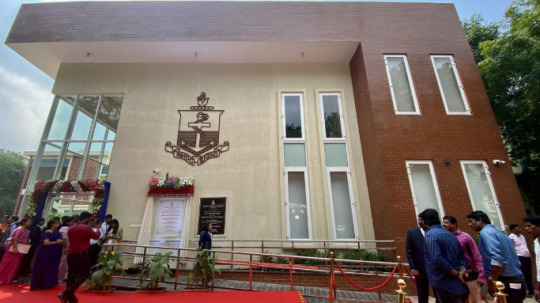
Emergence of Incubation Cells in Arts and Science Colleges
While engineering colleges have long been known for their focus on start-ups, a growing number of arts and science colleges in Tamil Nadu are now stepping up to the plate. Colleges like Madras Christian College (MCC) are leading the charge. In 2020, MCC established the groundwork for an incubation cell, and by 2022, it rolled out comprehensive start-up support programs designed to help students turn their ideas into reality.
The MCC-MRF Innovation Park at Madras Christian College is one such example, where MRF Foundation has contributed ₹30 crore to help set up the park, giving students access to cutting-edge resources and mentorship. The incubation cell offers students funding of up to ₹1 lakh, making it easier for budding entrepreneurs to materialize their ideas without significant financial barriers.
Partnerships with Key Players in the Entrepreneurial Ecosystem
A crucial aspect of this entrepreneurial push in colleges is the formation of strategic partnerships. By collaborating with key players in the entrepreneurial ecosystem, colleges are bridging the gap between academic knowledge and real-world application. These partnerships provide students with mentorship, industry connections, and access to networks that are pivotal for the success of any start-up.
In addition, many colleges are establishing ties with successful entrepreneurs, start-up incubators, and venture capitalists to offer real-time insights into business strategies. These collaborations are enabling students to gain a comprehensive understanding of what it takes to launch and sustain a successful business in today's fast-paced market.
Funding and Support for Aspiring Entrepreneurs
The financial backing and support available for students in Tamil Nadu’s arts and science colleges are becoming more robust. For example, as mentioned earlier, Madras Christian College provides students with funding of up to ₹1 lakh through its incubation cell. Additionally, research and development grants are given to professors to encourage research-driven innovation. Such financial support plays a pivotal role in fostering entrepreneurship among students who might otherwise struggle with initial capital requirements.
This shift is evident not only in engineering students but also in students pursuing arts, science, and commerce courses. Whether it's technology, social entrepreneurship, or sustainable business models, the entrepreneurial mindset is gaining traction across various disciplines, allowing students to challenge the status quo and explore innovative ventures.
The Role of Innovation Parks and Start-up Ecosystems
The launch of innovation parks like the MCC-MRF Innovation Park marks a critical step in supporting entrepreneurship within colleges. These parks provide students with the infrastructure, resources, and guidance needed to build prototypes, test their business ideas, and develop sustainable start-ups. Furthermore, the creation of such innovation hubs provides a supportive community where entrepreneurs can collaborate, share ideas, and grow together.
The start-up scene in Tamil Nadu is thriving, and arts and science colleges are positioning themselves as crucial players in this ecosystem. With the help of incubation centers, entrepreneurial programs, and strategic industry partnerships, these institutions are empowering students to step outside the traditional career paths and create their own entrepreneurial ventures.
Conclusion: A New Era of Entrepreneurial Education in Tamil Nadu
The entrepreneurial spirit in Tamil Nadu is undergoing a major transformation. What was once reserved for engineering and management students is now spreading across all disciplines, with arts and science students at the forefront. As more colleges enhance their incubation facilities and form connections with key figures in the start-up ecosystem, the future looks bright for young entrepreneurs looking to make their mark on the world.
0 notes
Text
Are Incinerators in Kerala Environmentally Friendly? What You Need to Know

Introduction
As Kerala faces rising waste generation due to rapid urbanization and tourism, finding effective disposal methods is a growing concern. One widely used solution is incineration — the process of burning waste at high temperatures to reduce volume and eliminate harmful pathogens. But with increasing awareness about environmental sustainability, many are asking: Are incinerators in Kerala truly eco-friendly?
This article explores how incinerators are being used across Kerala, the environmental challenges they pose, and the steps taken to ensure greener, cleaner solutions.
What Are Incinerators and How Are They Used in Kerala?
Incinerators are waste treatment units that burn solid waste to ash, gas, and heat. In Kerala, they are commonly used by:
Hospitals and healthcare facilities for biomedical waste
Municipal corporations for household garbage
Industrial units to manage hazardous materials
They are particularly effective in controlling diseases and reducing landfill usage, which is critical in Kerala’s densely populated areas.
Environmental Concerns with Incinerators
Despite their benefits, traditional incinerators have raised several environmental red flags:
Air Pollution: Incineration can release harmful gases like dioxins, furans, and carbon monoxide if not properly managed.
Toxic Ash: The residue left behind can contain heavy metals and other pollutants, requiring safe disposal.
Carbon Footprint: Burning waste contributes to greenhouse gas emissions unless energy recovery systems are integrated.
What is Kerala Doing to Improve?
Kerala has taken several progressive steps to address these concerns:
✅ Installation of advanced incinerators with air pollution control systems (scrubbers and filters)
✅ Strict pollution control norms set by the Kerala State Pollution Control Board (KSPCB)
✅ Training programs for proper operation and maintenance in hospitals and public facilities
✅ Shift toward decentralized waste management, reducing dependency on large incineration units
Some municipalities are also investing in waste-to-energy incinerators, which convert heat into usable electricity, adding a sustainability angle to the process.
Eco-Friendly Alternatives to Incineration
While incinerators are necessary in some sectors, Kerala is also exploring alternatives such as:
🌱 Biogas plants for organic waste
🌱 Composting at the community and household level
🌱 Material Recovery Facilities (MRFs) for segregation and recycling
The goal is a circular economy that minimizes waste and maximizes reuse.
Conclusion
Incinerators in Kerala remain an essential part of the waste management ecosystem, especially for medical and hazardous waste. However, concerns about pollution and sustainability mean that they must be used responsibly and complemented with greener alternatives. As the state continues to modernize its waste infrastructure, balancing hygiene and environmental health is key to creating a truly sustainable Kerala.
0 notes
Text
World Creativity and Innovation Day – 21 April
World Creativity and Innovation Day is observed globally every year on 21 April to highlight the pivotal role of creativity and innovation in addressing global challenges. This day serves as a reminder of how fresh ideas and innovative thinking can drive progress towards achieving the United Nations Sustainable Development Goals (SDGs), also known as the "Global Goals." It emphasizes the importance of imagination and ingenuity in shaping a better, more sustainable future for all.
Internship Experience at Pentagon Innovation, MRF - Madras Christian College (MCC)
As an intern at Pentagon Innovation, a budding IT startup under MRF MCC, I had the privilege of guiding students who aspired to explore diverse career paths in software development, web and app development, human resources, recruitment, and sales. The organization specializes in building digital applications and delivering them to small-scale enterprises, fostering innovation and practical solutions within the business landscape.
GUIDING THE NEXT GENERATION
During my internship, I took on the responsibility of mentoring students, providing them with real-world insights into various roles within the tech and corporate sectors. I helped them recognize the essential skills and competencies required for each domain, shared industry trends, and narrated my personal journey to encourage and uplift them. It was a fulfilling experience to see young minds become curious, confident, and career-ready.
MESSAGE FOR VOLUNTEERS AND THE ESTABLISHMENT
“I'm thrilled to share my experience as an intern at Pentagon Innovation, MRF MCC, where I had the opportunity to guide and inspire students in their pursuit of careers in technology and beyond. As a volunteer, I am passionate about empowering future innovators and entrepreneurs. Let us continue to build a nurturing environment that fosters curiosity, collaboration, and creativity — the true pillars of progress.”
As the event drew to a close, the Principal of Madras Christian College extended heartfelt congratulations to all participating students, recognizing their enthusiasm, dedication, and commitment to learning.
By:
S. Anish Navya
Student UNV
B.Sc. Statistics
Department of Statistics
Madras Christian College, Chennai
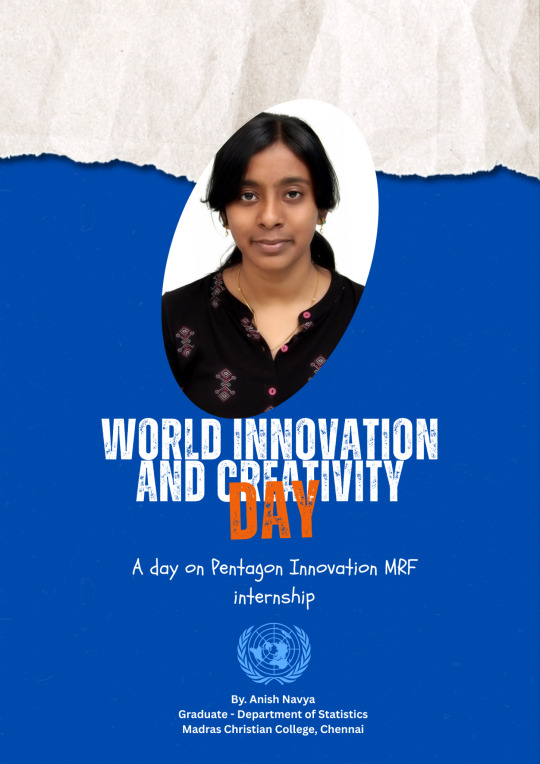
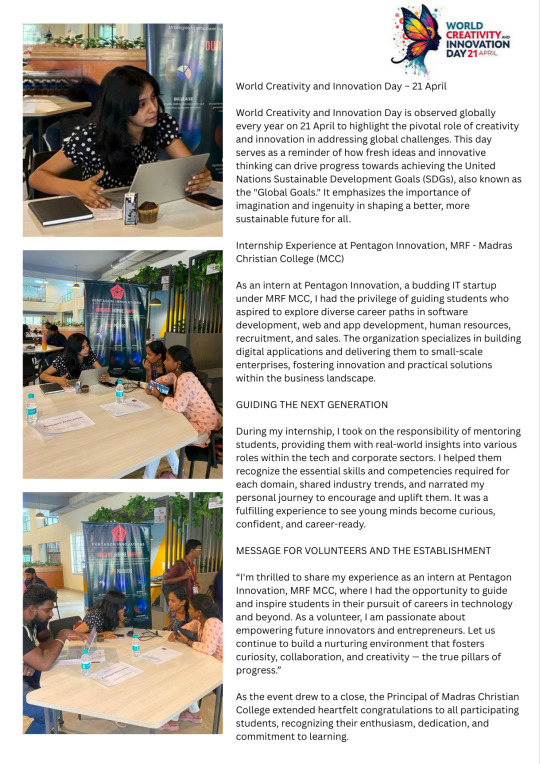
0 notes